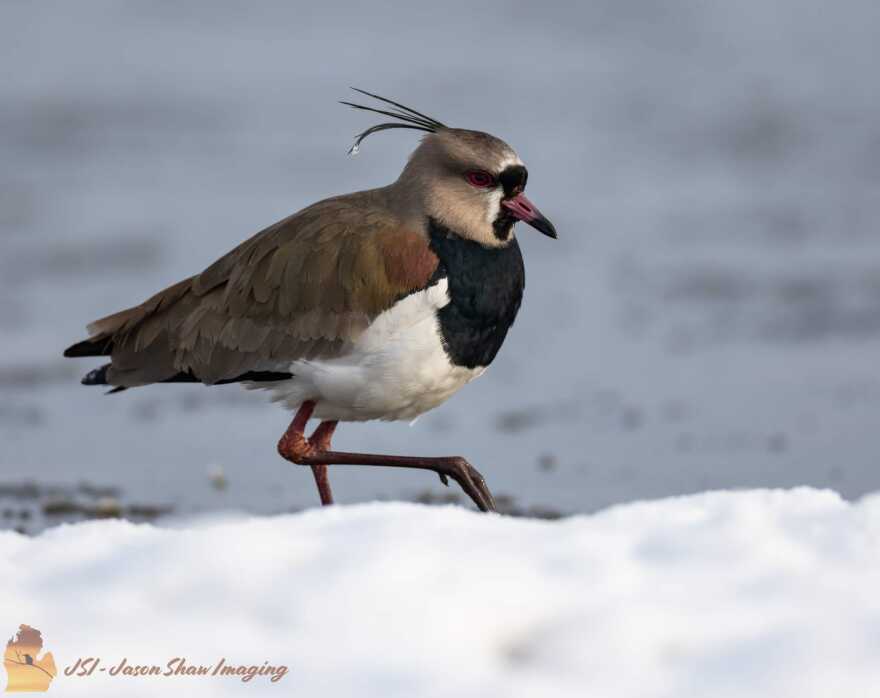A lost, tropical bird made a home for itself in northern Michigan more than a year ago. Now, the unusual visitor is the first confirmed record of its species in North America.
A southern lapwing spent nearly six months in Oscoda before vanishing in December 2022, as mysteriously as it appeared. The species is commonly found in grassy regions across South America and rarely strays north beyond Guatemala and Belize.
In a 5-2 vote, the Michigan Bird Records Committee (MBRC) affirmed the Oscoda visitor arrived on its own accord.
Scott Terry, chair of the MBRC, said the Oscoda lapwing is "exceptional." It stayed in the region longer than most rare birds typically do, and how it ended up so far north is still a mystery.
"No matter [how it got here], it's a cool-looking bird," Terry said. "It's a great-looking bird, and it's a great record, no matter what people think."

The committee's decision rules out that the bird was a loose pet, escaped from any zoos or hitchhiked on a plane, among other possible human interventions.
With the decision, Terry said past sightings of the northern subspecies in Maryland and Florida may be re-evaluated. The case is now submitted for consideration by the American Birding Association, which would determine if the species should be added to the national bird list.
According to the Cornell Lab of Orinthology, the southern lapwing's distribution and abundance has "increased considerably" across Ecuador and Peru since the 1980s.
In more recent decades, the Cornell lab says the range of the shorebird is expanding into north Central America, possibly due to deforestation.
But Terry said the lapwing's extended stay in Michigan is likely an exception and not a part of any larger trend.
"They call it a 'stepping stone' species, they kind of leapfrog each other. They move slowly, but not very far," Terry said. "I don't know if you could say this bird showing up in northern Michigan has any sort of implications to their species as a whole."
Jason Shaw is a local birder and photographer, who visited the lapwing on a weekly basis while it was living in Oscoda. He said he's happy with the MBRC's decision, and it aligns with evidence gathered by birders.
Shaw said there were no southern lapwings in captivity that were unaccounted for, and the bird did not have clipped wings or bands on its legs. He said planes flying into Oscoda were also empty of cargo.
"The evidence gathered by people vastly outweighed the initial thought of it being a stowaway on a plane," Shaw wrote. "...There is too much evidence to support the wild bird decision."
The bird was first spotted in Michigan in May by a Kalitta Air employee outside the Wurtsmith Air Museum and reported in June 2022. According to local birders, the lapwing drew hundreds of bird-watchers from across the country, many of whom traveled to see the species for the first time.
Shaw said the lapwing was regularly seen by the Oscoda-Wurtsmith Airport and Van Etten Lake in the summer. It was also often spotted on the shore of the Au Sable River, and later in the fall, the bird hung around Cedar Lake, foraging for worms in mudflats.
Its presence sparked various theories on how a mostly-sedentary species could have traveled thousands of miles. Some suggested the bird was carried by an air current or ushered north after grouping up with a flock migratory pipers. There is no definitive proof to support or debunk these ideas.
In December 2022, WCMU reported the bird was last spotted Nov. 22 and had likely perished due to winter weather. Shaw told WCMU at the time, seeing the bird "was like seeing an old friend."
“It’ll definitely be talked about for the next few years, just the big event of having some bird that was really lost, come and land in Oscoda, in Michigan," he said.
Following that report, the lapwing was spotted in the Oscoda area a few more times. It was last seen by Shaw on Dec. 22.







